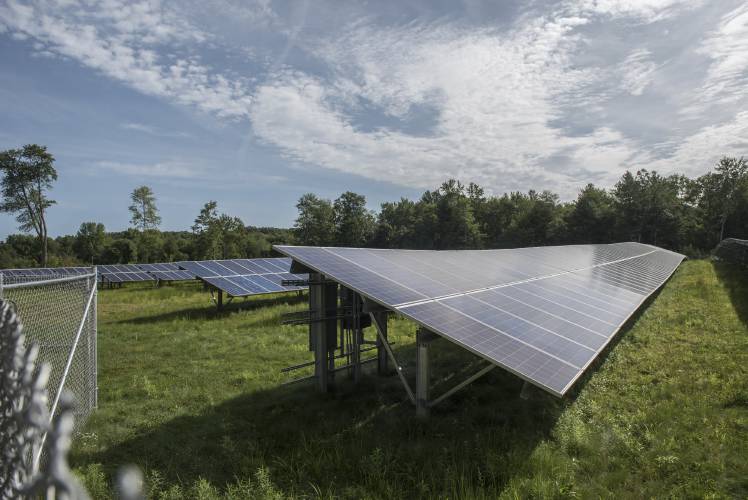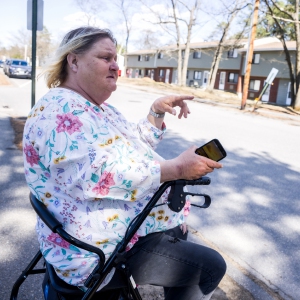Granite Geek: In a sign of the times, rooftop solar in New England produced 5 Seabrook Stations worth of electricity

View of an approximately 30-acre solar farm north of Pulpit Hill Road in Amherst, Mass. on Monday, Aug. 16, 2021. Daily Hampshire Gazette file photo
|
Published: 04-08-2024 12:54 PM
Modified: 04-09-2024 12:16 PM |
A decade ago concern spread among folks who ran power grids that too much wind and solar power, which comes and goes in semi-unpredictable ways, would cause our electric system to go all wonky. I remember 10% of total output being tossed around as a possible limit, then maybe 20% max.
That was then, but this is now: At noon on Saturday, March 30, a full 56% of the electricity being consumed in the six New England states came from wind and solar without causing the power grid to even blink, according to the resource-mix database run by ISO-NewEngland, which oversees the six-state grid.
When you add hydropower and nuclear power, a whopping 82% of New England’s electricity was coming from sources that produced no emissions at all.
The most astonishing part of that delightful result is that the majority of the renewable power, an estimated 5,964 megawatts of electricity, was coming from behind-the-meter solar panels, mostly rooftop arrays like mine. That’s a record for New England, the equivalent of five Seabrook Stations worth of electrons produced by a zillion small photovoltaic set-ups scattered all over the place, owned by individuals or mom-and-pop stores or little organizations.
Importantly, those five nuclear-power equivalents were mostly built in the last four years and did not require any new towers or poles or wires because they are close to users already. Speed of construction and bypassing the need for expensive new transmission are two of the big benefits of distributed solar power that sometimes get overlooked.
What was the financial result of all this electricity being produced by systems that consume no fuel? The per-kilowatt price of power fell to zero for a while – it even hit negative one cent, whatever that means – and New England had to buy virtually no electricity from New York or Canada, whereas normally such imports make up about 10% of our consumption.
Before you get too excited, this was an extreme case. Electricity demand is low on Saturdays and it was a breezy, sunny day with temperatures on the cool side so that the photovoltaic electronics was all operating at maximum efficiency. Such a result happens very rarely and even on that Saturday it only lasted for three or four hours.
Still, it’s a sign of how the century-old regional electric system is changing as we pivot to keeping our economy going with much less pollution. As offshore wind ramps up (finally!) and solar installations continue at their healthy clip, days like that will become more common.
Article continues after...
Yesterday's Most Read Articles
 Reclaiming Healy Park: A symbol of renewal and a reckoning with homelessness in Concord
Reclaiming Healy Park: A symbol of renewal and a reckoning with homelessness in Concord
 Home buying gets tougher as prices in New Hampshire continue to rise, outpacing national increase
Home buying gets tougher as prices in New Hampshire continue to rise, outpacing national increase
 Royal Gardens tenants worried about where they will live after building renovations
Royal Gardens tenants worried about where they will live after building renovations
 Concord school leaders grapple with lunch debt exceeding $100,000
Concord school leaders grapple with lunch debt exceeding $100,000
 ‘Love where you live’ – Market Days kicks off 51st annual festival
‘Love where you live’ – Market Days kicks off 51st annual festival
 Boutwell’s is now the biggest candlepin center in the state
Boutwell’s is now the biggest candlepin center in the state
That’s a change we can celebrate, but since we’re adults we realize there are also going to be changes we don’t celebrate as we work to limit the damage we are doing to the world our grandchildren must occupy. These changes will sometimes be painful and certainly be expensive and many will require us to stop doing things we like to do. We’ll mutter in irritation but live with it since the alternative is nobody living with much of anything.
But enough gloom. For the moment, hooray for renewables!







 Granite Geek: The circle of life is painful when watching the species-gets-killed part
Granite Geek: The circle of life is painful when watching the species-gets-killed part Concord’s two Rite Aid stores shutting soon
Concord’s two Rite Aid stores shutting soon
